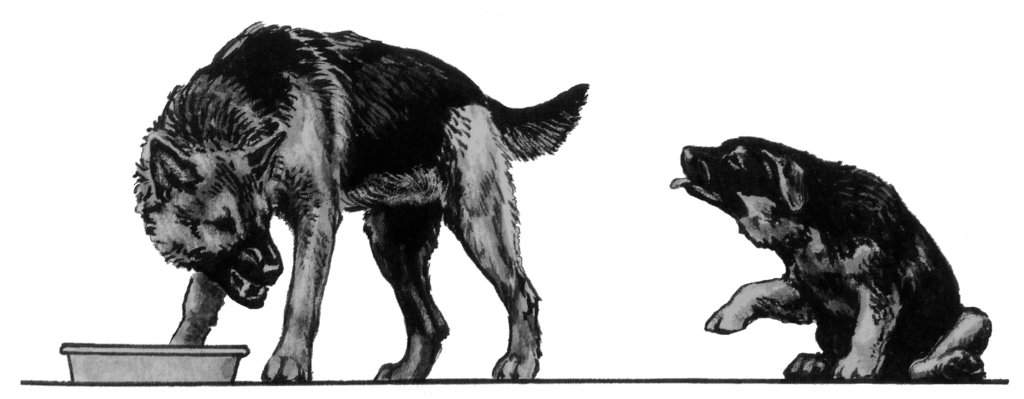Canine twist behavior—the puppy twists as a pacifying response to the adult’s growling (illustration by Alice Rasmussen from “Dog Language” by Roger Abrantes)
The canine twist behavior is a curious behavior that few dog owners recognize, let alone know what it means.
It is a characteristic behavior shown by any canine (wolf, dog, African wild dog, and dingo at least) when it twists one hind leg out to the side. They frequently show it from a sitting position, but they can also do it while standing. In cases where the dog appears very insecure, a half roll culminating with the dog lying on its back and presenting its belly may succeed the twist. Laid-back ears, semi-closed eyes, champing (at times with the tongue protruding out of the mouth), and paw lifting (or vacuum pawing), in various degrees depending on the level of insecurity, usually follow the twist. It’s a fairly common behavior primarily seen in puppies and youngsters, but insecure adults can also display it.
The function of the twist is to pacify an opponent. As always, behavior happens by chance (or reflex), and if it (the phenotype) proves to have a beneficial function, it will tend to spread in the population, transmitted from one generation to the next (via its genotype).
The twist’s origin is most certainly related to the canine female’s typical maternal behavior overturning her puppy by pressing her nose against its groin, forcing one of the puppy’s hind legs to the side. The puppy will then fall on its back, and the mother will lick its belly and genital area facilitating the puppy’s urination and defecation. To start with, the puppy seems to find it an unpleasant experience that becomes pleasurable once it rests on its back and its mother’s licking achieves its function.
Later on, the puppy will perform the same twist movement in the absence of any physical contact with the mother or any other adult. It will do it when it feels threatened or insecure and with the function to pacify both itself and its opponent, rather than to invite to belly licking.
The transition from urination/defecation to pacifying is a classic of the development of behavior. It happens almost exclusively via a classic conditioning process. In the beginning, being overturned is unpleasant but lying on its back, belly up, becomes pleasant (due to the puppy relieving itself). After some repetitions, the puppy will associate lying on its back with ending discomfort and will readily display this behavior whenever necessary.
The strength of the twist behavior (a general characteristic of pacifying behavior) is its double effect on both parties. The puppy relaxes by doing something which has produced desirable results earlier. The threatening adult relaxes by being met with behavior that it recognizes as infantile behavior.
I first described this behavior in the original edition of my book “Dog Language” in 1987. It had no name at the time. I coined the term twist behavior thinking of the sixties’ famous dance, very popular in my teen years. “Twist and Shout” by The Beatles* immortalized it. The Twist, the dance, featured a particular step, where the dancer’s legs made a twisting movement reminiscent of the puppy’s pacifying behavior.
____________________
* “Twist and Shout” was written by Phil Medley and Bert Russell and first released in 1961 featuring The Top Notes. However, it achieved its fame first when The Beatles performed it in 1963 with John Lennon in the lead vocals.
Related articles
- Canine Muzzle Grasp Behavior—Advanced Dog Language (canines, pacifying behavior, maternal behavior, parental behavior) 2012.04.25
- Pacifying Behavior—Origin, Function and Evolution (dogs, pacifying behavior, evolution) 2015.06.01
- Dominance—Making Sense of the Nonsense (aggressive, fearful, dominant and submissive behavior, social behavior, definitions of behavior, biology, dogs, genetics) 2011.12.11
- The Spectrum of Behavior (aggressive, fearful, dominant and submissive behavior) 2011.09.09
References
- Abrantes, R. (1997) The Evolution of Canine Social Behavior. Wakan Tanka Publishers.
- Abrantes, R. (1997) Dog Language. Wakan Tanka Publishers.
- Darwin, C. (1872) The Expressions of the Emotions in Man and Animals. John Murray (the original edition).
- Fox, M. (1972) Behaviour of Wolves, Dogs, and Related Canids. Harper and Row.
- Lopez, B.H. (1978). Of Wolves and Men. J. M. Dent and Sons Limited.
- Mech, L.D. (1970) The wolf: the ecology and behavior of an endangered species. Doubleday Publishing Co., New York.
- Mech, L.D. (1981). The Wolf: The Ecology and Behaviour of an Endangered Species. University of Minnesota Press.
- Mech, L.D. (1988) The arctic wolf: living with the pack. Voyageur Press, Stillwater, Minn.
- Mech, L.D. and Boitani, L. (2003) Wolves: Behavior, Ecology, and Conservation. University of Chicago Press.
- Scott, J.P. and Fuller, J.L. (1998) Genetics and the Social Behavior of the Dog. University of Chicago Press.
- Trumler, E. (1995) Mit dem Hund auf du: Zum Verständnis seines Wesens und Verhaltens. Piper Taschenbuch; 17. edition. ISBN-10 : 3492211356
- Zimen, E. (1975) Social dynamics of the wolf pack. In The wild canids: their systematics, behavioral ecology and evolution. Edited by M. W. Fox. Van Nostrand Reinhold Co., New York. pp. 336-368.
- Zimen, E. (1982) A wolf pack sociogram. In Wolves of the world. Edited by F. H. Harrington, and P. C. Paquet. Noyes Publishers, Park Ridge, NJ.
Learn more in our course Ethology. Ethology studies the behavior of animals in their natural environment. It is fundamental knowledge for the dedicated student of animal behavior as well as for any competent animal trainer. Roger Abrantes wrote the textbook included in the online course as a beautiful flip page book. Learn ethology from a leading ethologist.

